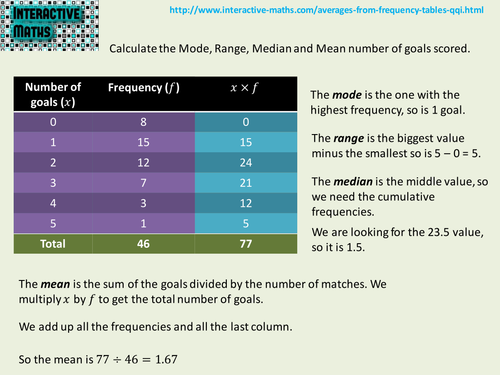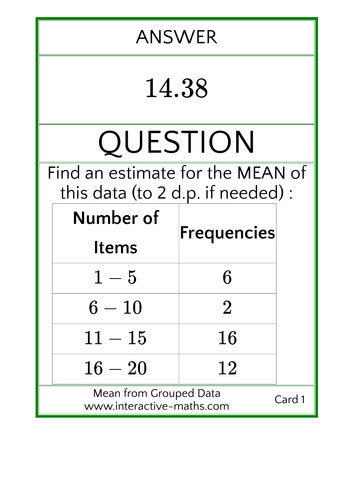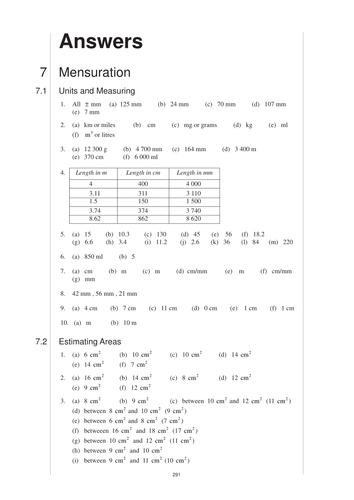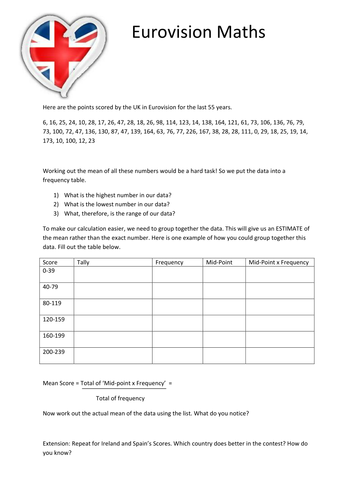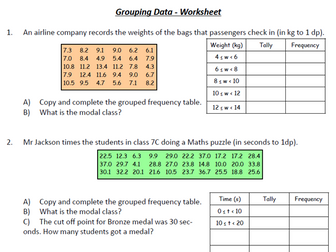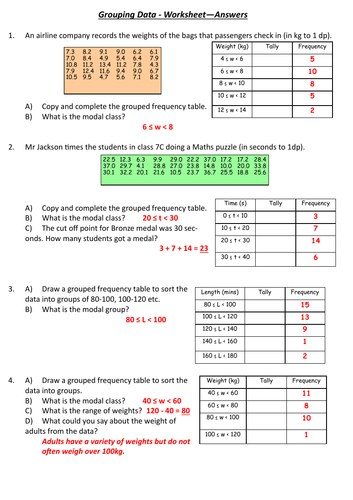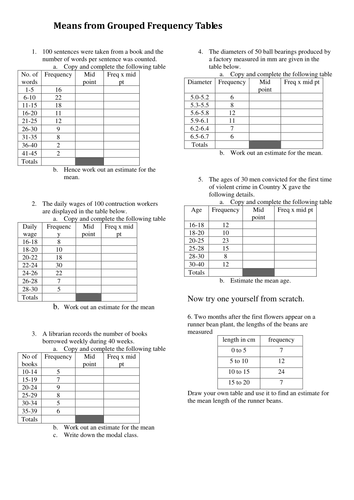Calculating averages and range from grouped data
Lesson presentations and activities
A simple powerpoint that starts with an example of finding the averages from a frequency table, and goes on to find averages from a grouped frequency table. The word file is a set of notes to stick in for simple tables (meant as revision). Let me know what you think.
Reviews
scorpiosami3 years ago
Great revision task with students
ollytravel4 years ago
Thank you!
tracyhow24 years ago
Just what was needed. Thank you for sharing.
Lesson and worksheets to help students with finding the mean from group data. Differentiated and two plenaries. Can take 2 lessons.
Reviews
lorrainefrost7 months ago
What I needed with no faff
jafele10 months ago
Thank you very useful
tracyhow24 years ago
Good practice questions. Thank you for sharing.
A treasure hunt activity on finding the estimated mean from grouped data. Answers included on last page. Print 4 per page to save paper! You can create more of these treasure hunts on a variety of topics for free at http://generator.interactive-maths.com/
Reviews
karen_baggs7 years ago
MarkGreenaway7 years ago
TES Resource Team7 years ago
Thank you for publishing your resource. It has been selected to be featured in a new secondary maths collection.
Practice questions, homeworks and assessments
The topic of Data Analysis from the GCSE books of the Mathematics Enhancement Program. For information about these resources and an index for the whole collection please visit https://www.cimt.org.uk/projects/mepres/allgcse/allgcse.htm
Keywords: Statistics, Data, Grouped, Cumulative Frequency, Box Plot, Box and Whisker Diagram, Curve, Median, Quartile, Upper, Lower, Percentile, Distribution, Inter quartile Range, Semi Inter quartile, Frequency Polygon, Total, Percentage, Mean, Mode, Frequency Table, Class Width, Standard Deviation, Variance, Range, Spread, Distribution, Compare, Calculation, Justify, Evidence.
Reviews
MissJMorrison4 years ago
The answers do not match the workbook.
TES Resource Team7 years ago
Thank you for publishing your resource. It has been selected to be featured in a new secondary maths collection.
kaythikyaw_ygn7 years ago
A worksheet that gets students to estimate the mean of the UK's score at the Eurovision Song Contest to date - quite topical for the moment! Differentiated so at first students get given the table to estimate the mean and the data is grouped for them. Further examples require students to make their own tables.
Reviews
rachelctottman3 years ago
fab, thank you so much
TES Resource Team7 years ago
Thank you for publishing your resource. It has been selected to be featured in a new secondary maths collection.
dwatson8028 years ago
Fantastic idea, I have always enjoyed Eurovision now I get to do it in maths class :) Thanks for sharing.
Booklet with assessments at the start and end of the lesson on:
- Averages from a list
- Mean from a frequency table
- Mode, Range, Median from a frequency table
- Averages from grouped frequencyReviews
sfoms15 months ago
Great for revision
hankboot2u2 years ago
Great resource. Thank you for sharing.
tracyhow24 years ago
Thank you for sharing, this will be useful.
I put together a worksheet using questions from the MyMaths KS3 1C and Key Maths 8^3 (revised) textbooks. The books themselves are sparse, so I decided a worksheet is more practical and easier.
The questions selected are such that they get progressively more demanding in terms of selecting class intervals and the type of data.Included is a main worksheet (with a challenge question) and the answers for both worksheet and challenge question.
I hope this helps!
- Hayden Pullum
Reviews
Noel_Hopper7 months ago
good resource
tina_randle72 years ago
Thank you for sharing! It is useful for me to teach my year 8 straight away.
bobtes3 years ago
nice! thankyou
Practise at estimating the mean from grouped frequency tables. Suitable for those students who need the tables drawn for them at first
Reviews
kburn14 years ago
Useful
dcnland5 years ago
This worksheet is incorrect for continuous data. On q.4, what if we have a ball with a diameter of 5.25cm? You need to write the intervals using inequalities
louise12886 years ago
Excellent, thank you! Do you have the solutions?






